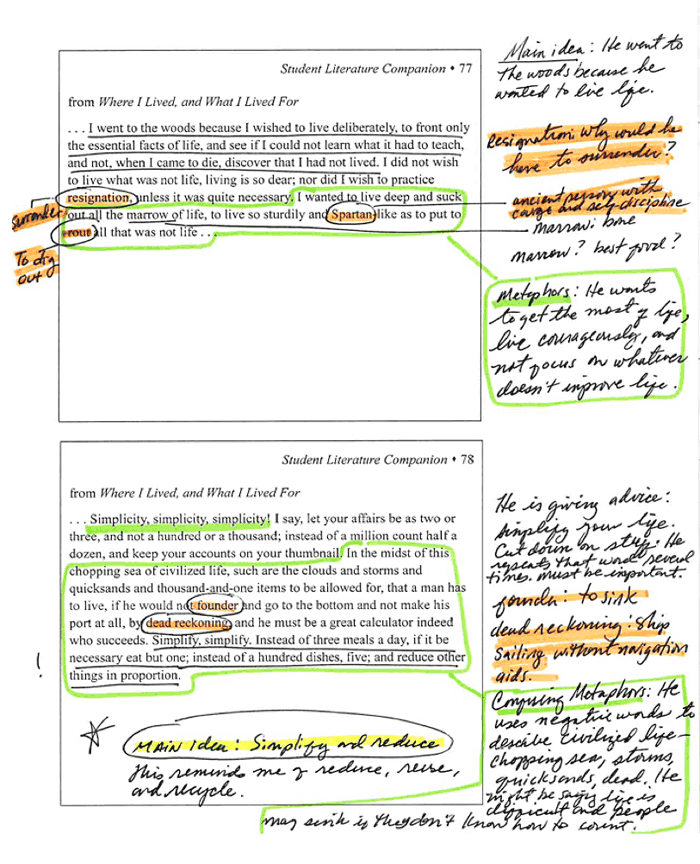How to Annotate
There is no one right way to annotate. As you get used to the idea, you will develop your own way to interact with whatever you read. Here are some hints to help you get started:
- Interact with the book; talk back to it. You learn more from a conversation than you do from a lecture. (This is the text-to-self connection.) Use question marks, exclamation marks, smiley faces, stars, and other icons. You might even color your favorite sections. Draw pictures or use graphic organizers to help you sort material. Sometimes when you talk to a book, you might want to do more than use a symbol; you might want to really “talk” to the book. Feel free to make comments, agree or disagree. Relate what you are reading to personal experiences, other books, and even songs. Make what you’re reading a personal experience.
- Learn what the book teaches. (This is the text-to-world connection.) Underline, circle, or highlight key words and phrases. Put your own summaries in the margin. Leave a trail in the book that makes it easier to follow when you study the material again by writing subject matter headings in the margins. Bracket or highlight sections you think are important. In the margin you might start a working outline of the section you’re reading. Every time you come across a word you don’t know, find the definition and write it into the margins.
- Pick up the author’s style. (This is the reading-to-writing connection.) Start by thinking about the tone of the piece. Ask yourself, “What did the writer do to help me understand the tone?” Jot your answer in the margin. Look for patterns. What stands out to you? Circle or underline parts of speech with different colored pens, pencils, or crayons. Circle or underline rhetorical devices with different colored writing instruments or surround them with different geometric shapes. Comment on sentence length, sound devices, figurative language—anything you can think of!
|
Within the text or on clear sticky notes, you can use the following tools and techniques for note-taking: |
In the margins or on sticky notes, you can write the following information: |
|
|

Source: “Reading,” Phillip Martin
How you annotate doesn’t matter as much as long as you are consistent. Using the same annotations consistently helps you remember why you annotated an idea.
For example, if you always circle the main idea, you will immediately find the main idea when you look back in the text. Of course, if the main idea is not stated directly, then you will need to write your summary of the main idea in the margin and circle it.

Source: Henry David Thoreau; Library of Congress, American Memory collection
By physically circling the main idea as you read, you will force yourself to find it, which will help you to quickly identify and remember the main idea when you study.
Remember: When you can’t write in your book, photocopy the page or use sticky notes. This will allow you to annotate freely without defacing a borrowed book.
Let’s take a look at how one reader annotated excerpts from Henry David Thoreau’s Walden and noted unfamiliar words, the main idea, and metaphors. In 1845, Thoreau moved into the woods where he studied nature and wrote. His book Walden was named after the pond in the woods where he lived.

Can you draw conclusions from the reader’s annotation? Using your notes, answer the questions below. Check your understanding when you are finished.
- What ideas did the reader underline?
- What did she highlight in orange?
- What did she highlight in green?
- What ideas did she set in the margin?
- How would you annotate these excerpts differently?
Sample Responses:
- The reader uses underlining to define the main idea of the excerpts.
- She highlights vocabulary or unknown allusions in orange. She defines these in the margin.
- She highlights confusing passages in green. Alternatively, the reader might be pointing out metaphors.
- Thoughts, summaries, definitions, questions, and connections are written in the margins.
- Answers will vary.
The annotations of the Walden excerpts show only one reader’s notes. There is no right or wrong way to annotate. You can choose your own annotation style based on what you know or want to know about the text. You can use all the colors you want. You can invent icons for different uses. It’s all up to you.
Effective annotation is a skill that must be developed through practice. It requires thought, planning, and consistency. If you do it well, it will help you to understand and remember what you read. If you don’t do it well, it will do little more than provide you with patches of colored text.
Let’s look over another student’s annotation of the same page. What does the reader annotate in this excerpt? Do you think her annotations are helpful? Why or why not?

Sample Response:
The reader makes no distinction among ideas. She doesn’t provide definitions for difficult words, doesn’t summarize in her own words, and doesn’t interact fully with the text. It will be difficult to return to this page and quickly remember the content.
Close